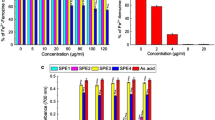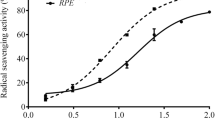Abstract
Caffeic acid phenethyl ester (CAPE) is a natural product with potent anti-inflammatory, antitumor, and antioxidant activities, and attenuates inflammation and lipid peroxidation. The purpose of the present study was to investigate the effects of CAPE on iron-induced liver damage. Rats were divided into four groups and treated for 7 days with saline (control group), 10 µmol kg CAPE/day s.c. (CAPE group), 50 mg iron-dextran/kg i.p. (IRON group) and CAPE and iron at the same time (IRON+CAPE group). Seven days later, rats were killed and the livers were excised for biochemical analysis. The administration of IRON alone resulted in higher myeloperoxidase (MPO) activity and lipid peroxidation than in the control and CAPE treatment prevented the increase in MPO activity and malondialdeyde (MDA) level. No differences were observed in all four groups with regards to superoxide dismutase (SOD), glutathione peroxidase (GSH-Px) and catalase (CAT) activities. Our results collectively suggest that CAPE may be an available agent to protect the liver from injury via inhibition of MPO activity.
Similar content being viewed by others
References
Ramm, G.A., Ruddell, R.G. (2005): Hepatotoxicity of iron overload: mechanisms of ironinduced hepatic fibrogenesis. Semin Liver Dis, 25, 433–449.
Bacon, B.R., Britton, R.S. (1990): The pathology of hepatic iron overload: a free radical—mediated process?Hepatology, 11, 127–137.
Britton, R.S., O’Neill, R., Bacon, B.R. (1990): Hepatic mitochondrial malondialdehyde metabolism in rats with chronic iron overload. Hepatology, 11, 93–97.
Britton, R. (2000): “Hemochromatosis: Genetics, Pathophysiology, Diagnosis and Treatment”. Cambridge University Press, New York.
Niederau, C., Fischer, R., Purschel, A., Stremmel, W., Haussinger, D., and Strohmeyer, G. (1996): Long-term survival in patients with hereditary hemochromatosis. Gastroenterology, 110, 1107–1119.
Olynyk, J.K., St Pierre, T.G., Britton, R.S., Brunt, E.M., Bacon, B.R. (2005): Duration of hepatic iron exposure increases the risk of significant fibrosis in hereditary hemochromatosis: a new role for magnetic resonance imaging. Am J Gastroenterol, 100, 837–841.
Tseng, T.H., Lee, Y.J. (2006): Evaluation of natural and synthetic compounds from East Asiatic folk medicinal plants on the mediation of cancer. Anticancer Agents Med Chem, 6, 347–365.
Okutan, H., Ozcelik, N., Yilmaz, H.R., and Uz, E. (2005): Effects of caffeic acid phenethyl ester on lipid peroxidation and antioxidant enzymes in diabetic rat heart. Clin Biochem, 38, 191–196.
Sud’ina, G.F., Mirzoeva, O.K., Pushkareva, M.A., Korshunova, G.A., Sumbatyan, N.V., Varfolomeev, S.D. (1993): Caffeic acid phenethyl ester as a lipoxygenase inhibitor with antioxidant properties. FEBS Lett, 329, 21–24.
Ilhan, A., Koltuksuz, U., Ozen, S., Uz, E., Ciralik, H., and Akyol, O. (1999): The effects of caffeic acid phenethyl ester (CAPE) on spinal cord ischemia/reperfusion injury in rabbits. Eur J Cardiothorac Surg, 16, 458–463.
Fadillioglu, E., Oztas, E., Erdogan, H., Yagmurca, M., Sogut, S., Ucar, M., Irmak, M.K. (2004): Protective effects of caffeic acid phenethyl ester on doxorubicin-induced cardiotoxicity in rats. J Appl Toxicol, 24, 47–52.
Rezzani, R., Giugno, L., Buffoli, B., Bonomini, F., and Bianchi, R. (2005): The protective effect of caffeic acid phenethyl ester against cyclosporine A-induced cardiotoxicity in rats. Toxicology, 212, 155–164.
Lowry, O.H., Rosebrough, N.J., Farr, A.L., Randall, R.J. (1951): Protein measurement with the Folin phenol reagent. J Biol Chem, 193, 265–275.
Esterbauer, H., Cheeseman, K.H. (1990): Determination of aldehydic lipid peroxidation products: malonaldehyde and 4-hydroxynonenal. Methods Enzymol, 186, 407–421.
Wei, H., Frenkel, K. (1991): In vivo formation of oxidized DNA bases in tumor promoter-treated mouse skin. Cancer Res, 51, 4443–4449.
Sun, Y., Oberley, L.W., and Li, Y. (1988): A simple method for clinical assay of superoxide dismutase. Clin Chem, 34, 497–500.
Aebi, H. (1974): “Methods of Enzymatic Analysis”. Academic Press, New York.
Paglia, D.E., Valentine, W.N. (1967): Studies on the quantitative and qualitative characterization of erythrocyte glutathione peroxidase. J Lab Clin Med, 70, 158–169.
Pardo-Andreu, G.L., Barrios, M.F., Curti, C., Hernandez, I., Merino, N., Lemus, Y., Martinez, I., Riano, A., and Delgado, R. (2008): Protective effects of Mangifera indica L extract (Vimang), and its major component mangiferin, on ironinduced oxidative damage to rat serum and liver. Pharmacol Res, 57, 79–86.
Hsu, D.Z., Chen, K.T., Chien, S.P., Li, Y.H., Huang, B.M., Chuang, Y.C., Liu, M.Y. (2006): Sesame oil attenuates acute iron-induced lipid peroxidation-associated hepatic damage in mice. Shock, 26, 625–630.
Livrea, M.A, Tesoriere, L., Pintaudi, A.M., Calabrese, A., Maggio, A., Freisleben, H.,, D’Arpa, D., D’Anna, R., and Bongiorno, A. (1996): Oxidative stress and antioxidant status in beta-thalassemia major: iron overload and depletion of lipid-soluble antioxidants. Blood, 88, 3608–3614.
Heinecke, J.W., Li, W., Francis, G.A., Goldstein, J.A. (1993): Tyrosyl radical generated by myeloperoxidase catalyzes the oxidative cross-linking of proteins. J Clin Invest, 91, 2866–2872.
Nicholls, S.J., Hazen, S.L. (2005): Myeloperoxidase and cardiovascular disease. Arterioscler Thromb Vasc Biol, 25, 1102–1111.
Saavedra-Lopes, M., Ramalho, F.S., Ramalho, L.N., Andrade-Silva, A., Martinelli, A.L., Jordao, A.A.J., Castro-e-Silva, O., and Zucoloto, S. (2008): The protective effect of CAPE on hepatic ischemia/reperfusion injury in rats. J Surg Res, 150, 271–277.
Panda, V.S., Naik, S.R. (2008): Cardioprotective activity of Ginkgo biloba Phytosomes in isoproterenol-induced myocardial necrosis in rats: a biochemical and histoarchitectural evaluation. Exp Toxicol Pathol, 60, 397–404.
Senthil, S., Sridevi, M., Pugalendi, K.V. (2007): Cardioprotective effect of oleanolic acid on isoproterenol- induced myocardial ischemia in rats. Toxicol Pathol, 35, 418–423.
Belboul, A., Lofgren, C., Storm, C., and Jungbeck, M. (2000): Heparin-coated circuits reduce occult myocardial damage during CPB: a randomized, single blind clinical trial. Eur J Cardiothorac Surg, 17, 580–586.
Tan, J., Ma, Z., Han, L., Du, R., Zhao, L., Wei, X., Hou, D., Johnstone, B.H., Farlow, M.R., and Du, Y. (2005): Caffeic acid phenethyl ester possesses potent cardioprotective effects in a rabbit model of acute myocardial ischemia-reperfusion injury. Am J Physiol Heart Circ Physiol, 289, H2265–2271.
Legssyer, R., Geisser, P., McArdle, H., Crichton, R.R., Ward, R.J. (2003): Comparison of injectable iron complexes in their ability to iron load tissues and to induce oxidative stress. Biometals, 16, 425–433.
Premkumar, K., Bowlus, C.L. (2004): Ascorbic acid does not increase the oxidative stress induced by dietary iron in C3H mice. J Nutr, 134, 435–438.
Author information
Authors and Affiliations
Corresponding author
Rights and permissions
About this article
Cite this article
Oktar, S., Yönden, Z., Aydin, M. et al. Protective effects of caffeic acid phenethyl ester on iron-induced liver damage in rats. J Physiol Biochem 65, 339–344 (2009). https://doi.org/10.1007/BF03185928
Received:
Issue Date:
DOI: https://doi.org/10.1007/BF03185928




